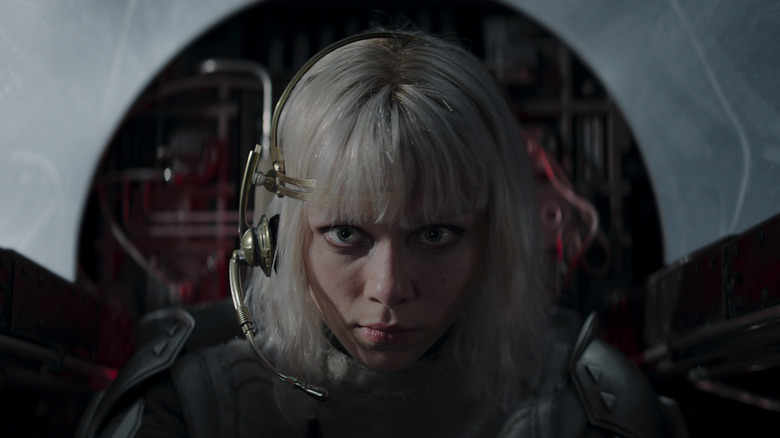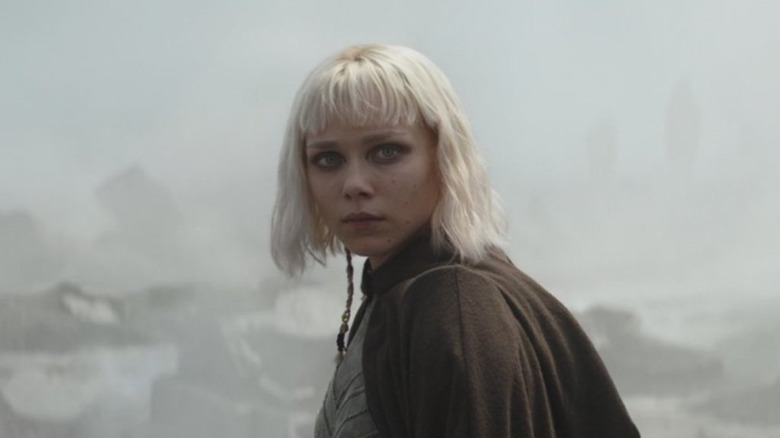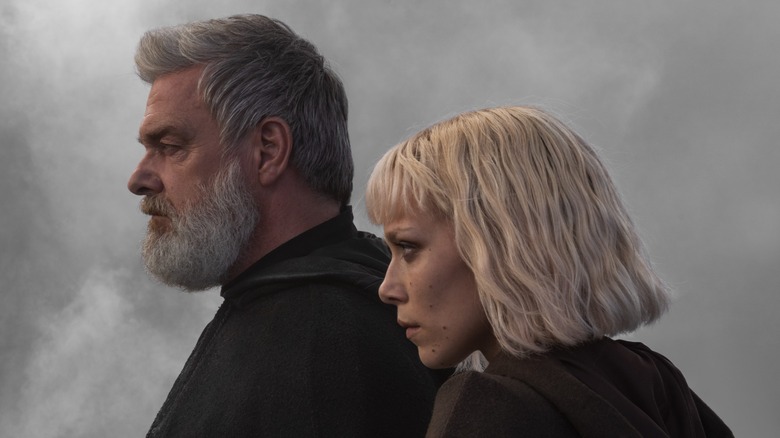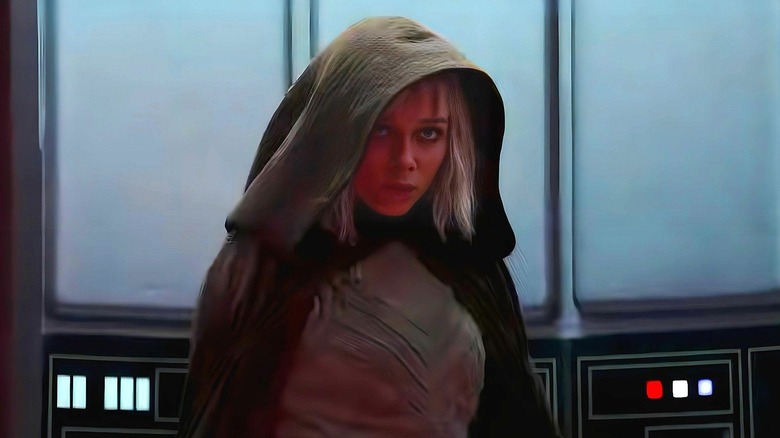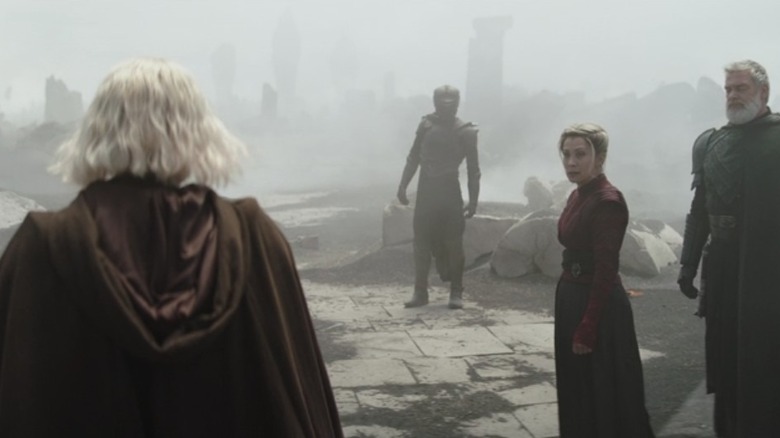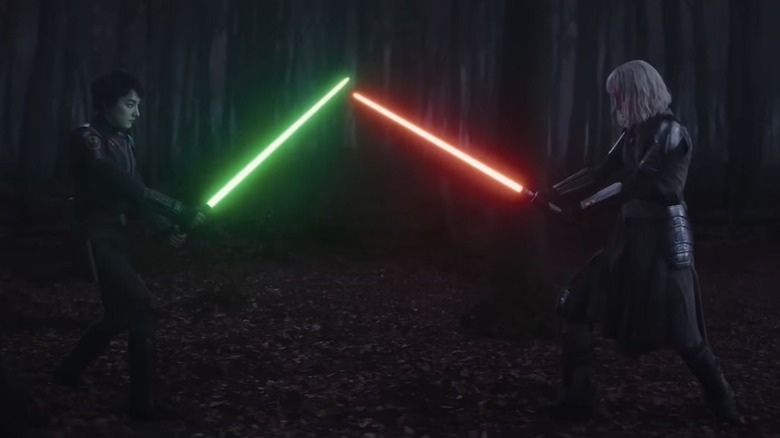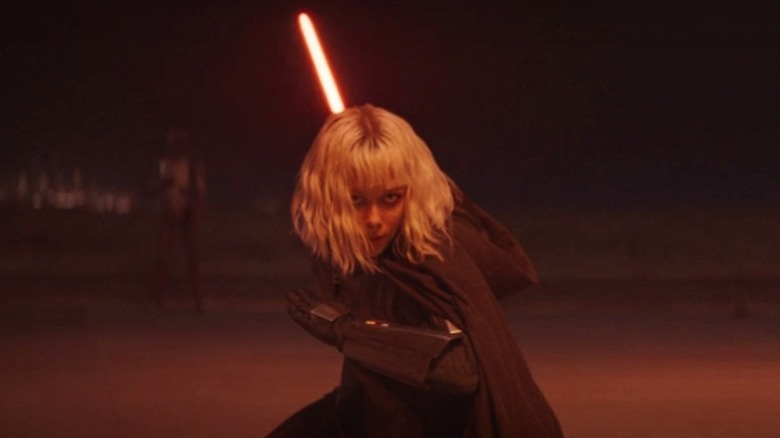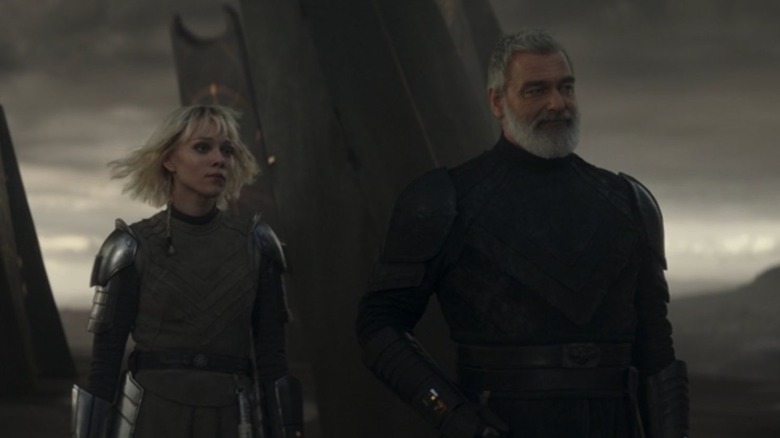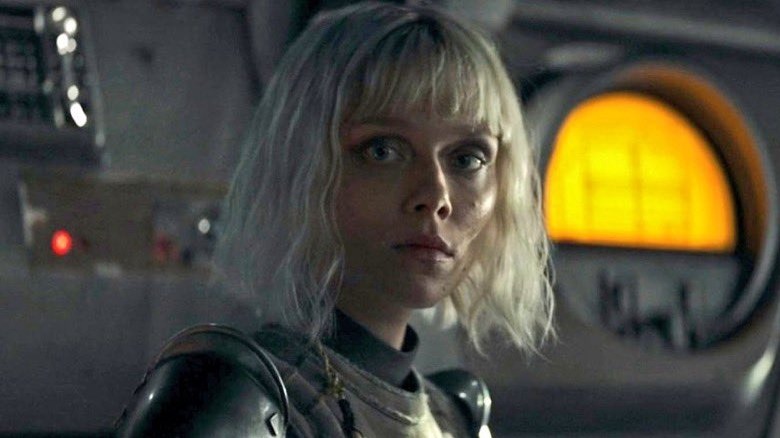The Untold Truth Of Baylan Skoll's Apprentice Shin Hati
Contains spoilers for "Ahsoka"
Dave Filoni, the executive creative director of Lucasfilm and visionary behind the animated series "Star Wars: The Clone Wars" and "Star Wars Rebels," continues weaving his grand tapestry with "Ahsoka." Though Filoni was heavily involved with previous Disney+ shows "The Mandalorian," "The Book of Boba Fett," and "Obi-Wan Kenobi," the character of Ahsoka Tano is his creation and the series that revolves around her is widely seen as his passion project. So far, "Ahsoka" has been a showcase for what many fans love most about the franchise: lightsaber duels, aerial combat, creatures and droids, and mystical religious orders (with some space politics thrown in for good measure). But for all its familiar faces and recognizable motifs, what's stood out to fans is the show's introduction of two mysterious antagonists.
Baylon Skoll and his apprentice, Shin Hati, aren't animated characters come to life like Sabine Wren, Huyang, Grand Admiral Thrawn, or Ezra Bridger. They haven't had the benefit of much screen time or dialogue. In fact, it's what we don't know about them that makes them so fascinating. That goes double for Shin Hati (Ivanna Sakhno) whose backstory and motivations are even more of a mystery than her master's. The sad and untimely death of Sakhno's costar, Ray Stevenson (who portrayed Baylon Skoll) likely means that, whatever these two Dark Jedi are up to, it'll be carried out by Shin Hati in the long run. Just who is this blunt-banged and sharp-tongued new "Star Wars" character? Time and Dave Filoni will tell, but this is what we know (and what we can surmise) as of now.
She's Padawan to Baylon Skoll
"Ahsoka" is having a lot of fun with the fact that the Jedi both exist and don't exist during the 10 years or so after the fall of the Empire. Baylon Skoll and Shin Hati use old Jedi flight codes to fool the crew of the Vesper and spring Morgan Elsbeth (Diana Lee Inosanto) from captivity. Skoll first refers to himself as a Jedi, then emphatically denies the claim only moments later. Throughout the series, he corrects anyone who assumes he still adheres strictly to Jedi standards and practices. However, it's clear that Hati is, in practice, his apprentice. She's working with him as a paid mercenary and he's using their shared mission as an opportunity to educate her.
Apprentice might be too vague a word for their relationship. Skoll and Hati may act as though they've moved beyond the ways of the Jedi, but she wears a braid that's unmistakably similar to the braids we've seen on young human Jedi such as Obi-Wan Kenobi (when he was Padawan to Qui-Gon Jinn) and Anakin Skywalker (when he was Padawan to Obi-Wan Kenobi). Though the distinction between an apprentice and a Padawan is quite small, it's not insignificant, especially in the case of Skoll and Hati. Padawan is a rank within the Jedi Order and a term that represents a more official relationship between a master and apprentice. That braid means two things. Not only does Skoll consider Hati to be his charge and his responsibility, but the two also believe it's important to maintain this symbolic Jedi tradition.
Skoll has big plans for her
Surely every Jedi Master hopes their Padawan will go on to do great things. But in Episode 6, "Far, Far Away," Baylon Skoll makes it known that he expects even more of Shin Hati. As Skoll explains to Hati that Ahsoka Tano (Rosario Dawson) and Sabine Wren (Natasha Liu Bordizzo) are in pursuit of Ezra Bridger (Eman Esfandi), she questions her master about his Jedi past. Skoll tells her that Ezra is too young for them to have met before and says that he, "comes from a breed of Bokken Jedi trained in the wild after the Temple fell." Bokken Jedi (a relatively new term to "Star Wars") are Force users who trained in the Jedi arts after Order 66 killed most members and drove the rest into exile. The word "bokken" is a reference to a wooden practice sword in Japanese.
Skoll's explanation takes on extra meaning when he compares Ezra (who practiced his mastery of the Force under Kanan Jarrus) to his Padawan. "He was trained as a Jedi. You I trained to be something more," he says. He's implying that all of the Jedi apprentices who acquired their skills from lone masters are like copies of copies of the real thing, and that they're bound by the Jedi concept of morality. But he's preparing Hati to be something more than a Jedi. What's more than a Jedi? Have we ever seen such a thing in "Star Wars?" And why doesn't Skoll view himself — once a member of the Order — as a lone master in the wild? It's a curious conundrum, especially since so much else about this pair reads (Dark) Jedi.
Her name has deeper meaning
Some "Star Wars" names just sound cool. Sometimes, the name itself gets an origin story long after we've met the character. Some are cute acronyms or plays on words (like the adorably needy droid, B2EMO). And sometimes, they're literary or historical allusions that might just contain story clues. So it is with Baylon Skoll and Shin Hati. Their characters' names are rooted in Norse mythology. Given that "Ahsoka" leans into the past and mysticism more so than any other "Star Wars" property as of late, it's impossible to ignore the coincidence.
In an ancient epic poem, Skoll and Hati are two wolves who bring about the end of the world (or Ragnarok) after they chase down and eventually catch the Earth's two celestial bodies. Skoll is the wolf who goes after the sun while Hati is the wolf who pursues the moon. In mythology and in pagan religions, the sun is often associated with masculinity while the moon is often associated with femininity, so these character names are consistent in that regard. The sun and moon are also symbolic of the beginning of time and the circular nature of time — two subjects in which Skoll is interested. Finally, the sun and moon frequently appear in the practice of witchcraft. It should be noted that a single sun and moon wouldn't be quite as powerfully symbolic in the world of "Star Wars," where some moons are populated and some planets have multiple celestial bodies. Still, that Shin Hati is named after a world-ending, moon-chasing wolf almost certainly portends some as-yet-unknown plot reveal.
She has complicated feelings about witches
Speaking of witchcraft, Baylon Skoll and Shin Hati are, at present, under the employ of Morgan Elsbeth. We first met Elsbeth as the Magistrate of Corvus in Season 2, Episode 5 of "The Mandalorian," when Ahsoka Tano tracks her down to gather intel on Grand Admiral Thrawn's whereabouts. In "Ahsoka," it's revealed that she's not only a devotee of Thrawn, she's also a descendant of the Nightsisters of Dathomir. In other words, she's a witch. Hati is surprised — and seemingly conflicted — to learn this about her benefactor. She continues to raise her eyebrows and make ever so slightly derisive comments whenever the subject of witchcraft comes up.
Witches and witchcraft are a recurring theme in "Ahsoka." The title of Episode 2 is "Toil and Trouble," which is a phrase taken from the Song of the Witches in Shakespeare's "Macbeth." The series also marks the first time we've seen the Nightsisters in live-action, and just as they do in "Macbeth," three strange witches have gotten involved with Thrawn's galactic politics. Until now, this female-only clan has existed only in "Star Wars" books, animation, and video games. They don't readily ally themselves with the Jedi or the Sith, and they use the Force in entirely their own way ... sometimes even to reanimate the dead. Hati's obvious mistrust of Elsbeth and the Nightsisters on Peridea suggests that their uneasy cooperation may come to a bitter end before the show is over.
The Force is strong with her
Who can use the Force and to what extent is another running theme in "Ahsoka." The series has set up something of a mirror narrative between Ahsoka and her apprentice, Sabine Wren, and Baylon Skoll and his apprentice, Shin Hati. There's tension (and a much hinted-at troubled past) between Ahsoka and Sabine. The pair has only just re-entered into a master and apprentice-type agreement, and Sabine's fitness and progress are constant sources of frustration. Ahsoka's pupil can hold her own in a fight and wield weapons — including a lightsaber — well enough, but her Force sensitivity is basically non-existent and her control over her own mind and heart is even less reliable. Skoll and Hati, on the other hand, seem to have a strong, steady working relationship built on mutual trust and respect.
Maybe that's why Hati is the superior pilot, combatant, and Force user. She's much cooler under pressure than Sabine. She had the upper hand throughout most of their two duels, nearly killing Sabine with a stab to the abdomen in their first encounter. And she's able to execute more advanced Jedi (or Sith) moves like Force pushing and Force choking as if she's as gifted as Anakin, Ahsoka, Luke, or Rey. Moreover, she's likely younger than Sabine, who's around 30 years old when the series takes place. We know Sabine's backstory, but we don't really know anything about Hati's origins as of yet, so just how powerful she is or could be remains an open question. The two seem to realize they're cosmically pitted against each other, which is tough luck for the Mandalorian Jedi-in-training.
Her lightsaber is her own creation
"Ahsoka" features some recognizable, fan-favorite lightsabers. There's Ahsoka Tano's twin white blades of light and Ezra Bridger's repurposed green lightsaber that's currently in the possession of Sabine Wren. The masked Marrok uses a familiar Inquisitor-type double-bladed spinning lightsaber with a circular hilt. Then there are the lightsabers used by Baylon Skoll and Shin Hati. When the trailer for "Ahsoka" dropped, fans noticed that they were both an unusual color. While historically, the Jedi have weapons made from green or blue kyber, the Sith have exclusively opted for red. Skoll and Hati's lightsabers bear a strong resemblance to, say, Darth Vader's, but they're perceptibly orange. The Force-using mercenaries haven't defined themselves yet (except to say they aren't Jedi), but these orange blades appear to indicate that they don't see themselves as beholden to the Dark Side.
The presence of Huyang on "Ahsoka," combined with the "Star Wars" timeline, gives us even more information about Hati's weapon in particular. Huyang was created about 25,000 years ago in the world of the franchise for the purposes of educating young Jedi about, among other things, the construction of lightsabers. He's a nearly infinite repository of data, and he recognizes Skoll and his lightsaber from the Academy. Huyang doesn't have information about Hati's, however, which means she probably didn't come by hers secondhand. Her hilt with its orange blade is almost certainly her own creation, made with the guidance of her master. Since mining the resources for a lightsaber and actually building one is no easy feat, there's got to be a good story behind it.
She's loyal to Skoll
Baylon Skoll and Shin Hati are positioned as the co-villains of "Ahsoka," along with Morgan Elsbeth and, of course, Grand Admiral Thrawn. Still, the word "villain" might end up being too severe to describe Skoll and Hati's role in the larger "Star Wars" story. For now, their interests are aligned with Elsbeth and Thrawn, but as soon as they make it to Peridea, Skoll already seems disinterested in the Nightsister and the Chiss' long-term goals. The former Jedi clearly has his own reason (besides the formidable sum he's being paid) for putting himself in harm's way and traveling to an entirely different galaxy, and he begins to articulate that reason to his apprentice when they're tasked with following Sabine Wren as she searches for Ezra Bridger. From his speech, we can tell that Skoll is disillusioned with just about everybody: The Jedi, the Sith, the Empire, the New Republic, and just about every other faction that operates within this (and the adjacent) galaxy.
Hati follows her master's lead in every way. It's obvious that her only loyalty is to Skoll. She's as cautious about Thrawn as she is about Elsbeth and the witches. And even when she wants to finish the job as it pertains to Sabine, she abides by Skoll's command and lets her be. "Star Wars" has been getting less black and white, and these two are among the best examples yet of free agents in an increasingly morally gray universe.
She's incredibly popular and mysterious
In its 45 years, the "Star Wars" franchise has grown to include more than 20,000 characters. But for every Luke Skywalker and Darth Vader, there are hundreds of incidental individuals who remain anonymous (or worse, hated) by the fandom. Each iteration has brought new fan favorites into the fold. The prequel trilogy gave us Qui-Gon Jinn and Darth Maul. "The Clone Wars" gave us Ahsoka Tano. The sequel trilogy will probably be best remembered for Kylo Ren and BB-8. And "The Mandalorian" introduced us to Din Djarin and Grogu.
The breakout character of "Ahsoka" may well be Shin Hati. Check X, formerly known as Twitter, or Reddit. The still-mysterious Hati has quickly developed a massive and rabid online following that hypothesizes about her identity, romanticizes her rivalry with Sabine Wren, and creates fan art about her in quantities that exceed her actual screen time. If she continues to be a factor in the overarching saga that Dave Filoni and company are telling, and if fans continue to be as into her as they currently are, she could eventually rank among those other "Star Wars" icons.
